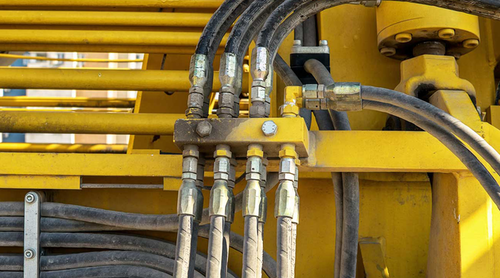Any modern hydraulic system more complicated than a simple push-and-return piston relies on hydraulic hoses to work. Hoses are made up of a rubber interior and exterior with a flexible metal framework, allowing for the transfer of hydraulic fluid (oil) from one point to another in the loop.
Hydraulic hoses (or pipelines) power the suspending and holding action seen in hydraulic rams and arms and can supply fluid over long distances to actuating engines. They’re also flexible devices, making them ideal for fitting to complicated, curving routes. However, selecting and using the appropriate hydraulic hose length isn’t as simple as it first seems. Wrongly-sized hoses result in your pumps and engines having to work harder to maintain fluid pressure level and motion across the whole loop, wasting energy and causing components to wear out faster.
Subtle changes can alter the pressure (PSI) travelling through the system. Hoses that are too short, thin, wide, or long can block or space fluid, resulting in pressure drops, overheating, and part failures. And awkwardly-shaped hoses can be tricky to connect and often won’t fit a fixed cladding (such as a mechanical arm). Therefore, it’s critical to match the size and specs of each hose to the layout and ratings of the pump, circuit, and cylinders.
Why Does it Matter What Size Hydraulic Hoses Are?
Three size measurements affect how flexing hydraulic hose assemblies perform and what they can handle:
1) Overall Length
The hose’s length determines how much hydraulic fluid will safely pass through the pipeline before it breaks, slows, or jams. Longer hoses can handle a greater volume and a more rapid hydraulic fluid flow rate.
You don’t want to use overly-long hoses in low-pressure systems as critical pressure drops and stalls can result. Long hydraulics can also sag, crimp, and catch on other parts. A lack of tight fastening can result in excess wear and the risk of micro-pressurised leaks developing from pinhole-sized breaches.
2) Inner Pipe Diameter (Bore)
Internal pipe diameter determines the rate and strength of fluid pressure following through the pipeline. Small-bore hoses can help concentrate PSI at crucial points – large-bore dissipates it (e.g. during reservoir back-flow). Engineers use bore changes to keep the pressure steady as it travels across the loop to convert into pure kinetic energy at the actuator or ram.
3) Outer Diameter (Insulation)
Outer diameter is the least important to active use, but it’s still vital to keep an eye on. The pipeline insulation can prevent heat, vibration, and fluid leaks from affecting the rest of the machine. Larger diameters are rated to handle more intense uses and rates of liquid flow. It’s also critical to pick an outer cladding that matches the fittings of the loop. Too thin or thick, and you could struggle to crimp them to fit your connecting O-rings.
Hydraulic Hoses and Much More from Hydrastar
Need quality hoses, connectors, or insulation for your hydraulic designs? Hydrastar work with clients throughout the UK and can ship anywhere in mainland Britain next-day. Call or email us today to learn more.
Image source: Machine Design



